The energy ability on which a pigeon can draw in a season are limited, so that when you prepare a pigeon for racing, you must not work it too hard so that it is able to draw on these reserves to the full when racing starts. For the reader who has read what we have written about the future
From the end of the mould untill pairing up time.
of the widowhood method, the following chapter will be a logical continuation on the subject. In the following articles we have compiled the basic idea which a fancier should follow during the winter months. In this period you must prepare the birds in the physical and moral sence as a first preparation for the following season. A good flyer may never lose sight of the ultimate object and must direct all his activities to this. The aim of an ordinary fancier is to win prizes, no matter what kind of races or in which time of the year. The aim of an artist is : to bring his birds into top condition for a chosen period, namely the period of the long distance races. This are the races he aims at and hopes to distinguish himself in.
Once the moult is over, the expenditure of energy declines and is limited to maintain the body and for the struggle against the cold. This is the proper time to let the body recover from the continues exertions caused by the heavy feeding during the racing and moulting period. When this heavy feeding is continued, and especially when the bird does not use any of its strenght, then this kind of feeding is very harmful : the consequences are detrimental and very often beyond repair.
The effect of this harms especial the liver and the muscular system. Many fanciers are too kind hearted with their pigeons and dislike limiting their feeding and are afterwards surprised that the results they had in view, are not forthcoming. At the least, eight out of ten times, the organism is damaged through too rich feeding and they are suffering from liver disease and to the surprise of their owner, their muscles are weakening. The same thing will happen to us, when we eat only meat and cake. It is logical and even necessary to feed them well during the breeding period, it is also logical and necessary to give a pigeon, which is deprived of its liberty, everything it needs during the moulting period. But it is absolutely logical and necessary to make use of the after season and winter to give the muscular system, the entestines etc. . ., the indispensable rest. Nothing wears out a moter more than it is continuously driven full out, the same applies to the internal organ which constitute the moter of a pigeon. We must draw the attention of the reader, who likes to succeed, to a special point: it is not absolutely necessary to keep pigeons in top form, even when one intends to show them during the winter months. You must not alter their habits in any way in preparing them for these shows. Many fanciers never show their best birds. Some of these small excursions will not harm them in the least if you follow the advice we are going to give you. Very calm pigeons will naturally not look as nice as their neighbours that have more fire in them, but what good will that do at this time of the year. A pigeon needs in wintertime all the rest it can get, to enable it to be in top condition when the racing season starts.
It is an established fact that pigeons that have been kept. separated for a long time, are better looking than pigeons that have been left together by their owner. But when it comes to the most important time, the racing season, it may be quiet possible that it is the other way round. This may seem to some illogically, but how many times have we not established this fact ourselves ? It is a fact, that dreams, good intentions and alluring theories are not enough, one must have experience, broadened through mistakes or confirmed by good results.
Experience is always better than reasoning. Everybody is trying to find something new, but the new things likes to find at any price, is not always synonym to better. But let us put all philosophy aside, it will not make our pigeons any better. Many fanciers have repeatedly asked us, to give a good feeding regime for the winter. We will repeat that there is no fast rule concerning the choice between the different kind of grain. Several systems may indeed give the same results. The most important thing is, to follow up as strictly as possible the percentages of the different grains. We will give, at the end of this book, a table of the different feeding regimes, intended four the four seasons. You don't have to be well educated to understand that the condition the birds are in at the start of the racing season plays a very important roll with regard to the output.
Even if the feeding problem is completely solved, it doesn't give any certainty concerning an ideal result. This is only the physical side of the business but we are sure that the mental side is also very important.
If one has to neglect this factor through not having the necessary time, the only solution would be a continuous or even a complete separated life of the pigeons.
To find out if it is necessary to keep them separated it is sufficient that if you have tried this system to ask yourself : Did I obtain better results when I kept my birds separated from the beginning of the moult untill the end of the winter ? If the answer on this question is not absolutely favourable or if you must concede by the evidence that the obtained results were not better than in previous years, you must discontinue this system and you must be honest and admit that you was worse off through the alteration. Firstly, you have made, without any benefit, the business more complecated and secondly, through imposing on the hens this separation, and in many cases have them locked up, which is really not necessary, you have seriously handicapped them. It is use less to have any illusions, only the results of an experience has any value. When the experiment is favourable, you must continue with this, if not, go back to the things you did before. All our pigeons, old and young ones, cocks and hens, old widowers and others, are kept together during the winter months, and we have no trouble to keep them this way untill three or four weeks before pairing up time, which is at the end of January. For some years, our yearlings were not separated at all but were only paired up during the months of September and October. We just took away, fourteen days before the agreed date, the hens of three widowers that we intended to chance to other hens. They were never given the opportunity to build a nest, but when we decided to open the nestboxes to get them on eggs, they were immediately full of fire and it took about the same time to get them on eggs as the others that were kept separated for three weeks. By quoting this experiment, which, we kept up for a few years, we are not trying to prove that this system is better than any other system. We only like to show the fact that our yearlings, both cocks and hens, which were not separated at all, were not in the least prevented from obtaining results which gave us the greatest satisfaction. We can give many more examples that are as good as ours and will give the same result. We have known and still know many small fanciers who only have very small lofts and are not able to separate their birds and still distinguish themselves.
Many of our readers will argue that it is impossible for them to keep their birds together without finding eggs in their loft. Our answer to them is, that not the birds are at fould nor the system but only their knowledge. Above all, don't misrepresent the fact, that you can obtain good results by separating your birds at the beginning of August before the moult and by pairing them up again around the first of November or by preventing them from breeding immediately after the racing season. To succeed at this you must have patience and be loking ahead.
First of all, you must around 1 November discourage them from building a nest by closing or dismantling the nest-boxes. The birds will then live together just the same as birds of the same sex. In Holland, were the temperature is lower, they are very easely kept that way untill the time they are paired up again. We, ourselves have two lofts joined together with a door in the middle which is kept open at the end of the season and also during the moulting
period and it is strange that we have more than once seen, that the hen had his perch in one loft and the cock in the other.
The meaning of grading your birds is, to select the best birds for racing and breeding for the following season. Selection on this basis will give security concerning the future the future breedin period and will enable you to improve your racing team.
It is during the long winter months that a forward looking fancier must take his time to consider the selection and also the pairing up of his pigeons. It is on the outcome of these problems that not only the breeding for the following years depend, but in most cases also the success of the coming racing season which, once New Years day is past, is soon upon us. The selection must be done very carefully and we must select pigeons that will give us the best racing team for the following racing season. To solve this problem one must first of all know exactly what one requires of them in the coming season. First of all, you must
fix a racing program that will suit your views and your expectations and also fit the means at your disposal. Once this work is done, you will be left with the pigeons that are the most likely ones to succeed with in the races you have planned for them. After the choice of program and the selection of the candidates, age will play an important roll. For example, it is an established fact that a fancier who sets his mind on flying the long distance races, must have at his disposal a larger number of mature pigeons because physical strength is not the only deciding quality for a long distance race. It sometimes occurs that obtained experience and endurance compensates for the defiency of the dynamism, that age brings along. It is for the same reason, that anybody that races the long distance races and wishes to obtain regular success, must have pigeons that wear well, pigeons that are not worn out before they have obtained the necessary experience to combat unfavourable weather conditions with success.
It is something else when it concerns short distance pigeons. Thanks to radio and other advantages, most short distance races are flown in favourable weather conditions. For that reason is experience obtained in this kind of races, not the most important factor. The greatest qualities of a short distance pigeon are : Fighting spirit and quick orientation abilities. Fighting spirit is a privilege of the youth. It is not deniable that a young pigeon is driven through dynamism, which obtains the upperhand on the less sharp ardour of the numerous older competitors. In the same line of thought we may not lose sight of the fact that the same applies in the preparation for the races, of which we have written in detail in our study of the widowhoodmethod. The slightest test will leave a strong impression on the more emotionally nervous system of a young pigeon, while it is sometimes very difficult to excite a more shrewd candidate that knows the tricks of the game. Once so far, the experience plays, so to say, an insignificant roll by the performances of a short distance pigeon. As a conclusion, it can be said, that a fancier, who races exclusively short distance races, must make sure that the greatest part of his team consist of the younger elements. One must remember, once and for all, that it is not the amount of prizes a fancier wins that counts but the value of the obtained performances. You cannot lose when you replace an old and worn out pigeon, which is only able, through declining strenght, to win minor places, with an young pigeon, full of fire, that has a whole future in front of it. This makes it necessary that a fancier, who only races in short distance races must breed every year some really good pigeons so that he can continuously re'uvenate his team. 
Exceptions to this rule of replacement are always possible. It can happen that a pigeon reaches an age when other pigeons are worn out and is still able to win prizes. Furthermore, you must never lose sight of the fact that such bonus pigeons, that stay indestructible and full of vitality, are as much necessary in the stock loft as in the racing team. A wise fancier will stop his best pigeons before they show any signs of decline. The same applies for long distance pigeons.
We will quickly go over the other points we use in sorting out, which are : Health, the moult, guaranty of origin, the outward qualities, the nervous system, the behaviour inside the loft and during the flight. A fancier who has the skill and knowledge will take every oppertunity to take observations and make up his mind what birds to keep and what birds to eliminate. These observations are sometimes more valuable than all scientific theories. An excellent fancier, who is a specialist in short distance races, made the following remark : When I come into the loft, I sometimes watch the behaviour of my pigeons for a long time. Some of them need 6 or 7 wingbeats to reach their perch, which is about 1.50 m high, others, which are more nervous, will reach it in only 3 or 4 beats. No need to tell you, that I always find the best ones among the latter. Many more observations can be made by a fancier who is bent upon making observations.
For fanciers, who have a profound knowledge of a pigeon, it is not very difficult to establish those physical qualities. They are mainly : balance, bone-structure, the muscular system, the form of the wing, feathering and vitality. It is a pity that the physical qualities are not outwardly vivible, it would help a judge to give his opinion. The internal organs of a pigeon, heart, lungs liver, glands and intestines, play an important roll in the performances of a pigeon, can only be judged by the conspicuous signs which show themselves by a veternary examination. This makes the task of a judge more difficult and preclude all unfailing opinions. We have been talking about a perfect and a simultaneously working of the internal organs of which the examination is very difficult. There is another question, also important, that even by the most skilful judge, very often, be misread : the physical qualities.
A pigeon can, in every respect, be built perfectly and can be in a excellent health. Nevertheless, this is not always an infallible sign of great value in the races. If it don't have at its disposal the will to win and a quick orientation ability, it will never be more than a midiocre pigeon.
At this point is the fancier who spent all his time with his birds, trains and studies them and knows their origin, in a better position to judge his own birds than the most skilful judge. His own observations and the basket are in this case his most valuable aid and his safest guide. All the particulars, we have just discussed, don't alter the fact that one must handle a pigeon so that one can examine and feel the sportive value of a pigeon. There are nowadays too many pigeons that are worn out before their time. The reason for this is, in principal, that the selection depends, in general, exclusively on the physical qualities, in other words, on the verdict of the basket, without taking notice of anything else. To keep up your position in the pigeonsport, you must not only be a good flyer but also a good breeder. Intelligence, will- power and physical abilities must, at the same time be improved. It sometimes happens that a pigeon follows a straight line home to its loft and has the mental drive to return as quick as possible but when is don't have the strenght to follow this up, it will all been in vain. Complete success depends on the two above mentioned factors : physical and mental qualities. A short distance fancier prepares his own downfall when he lets the basket be the only judge of the qualities of his birds. Long distance flyers also commit a mistake when they are only interrested in the outwardly diplayed qualities without taking into account the physical factor. To be certain of improvement, the two above discussed factors must be placed on equal terms. First of all : selection of the pigeon in the hand to decide the to physical condition and the sportive value which you must try to find out as accurate as possible. At the same time, you must put the birds to a profound test to make certain that intelligence, will-power and orientational abilities are still present in the breeding line.
If this work is practised from the beginning on pigeons of good origin, and is strictly kept up during the years, a great percentation of the discussed qualities will be obtained and you will be left with pigeons which are physically capable to materialize what was expected and which are, at the same time, able to combat for years the hardest races.
Inbreeding perpetuate the characteristics: It is practiced with perfect pigeons, which must have given the fancier complete satisfaction. It will keep the strain on the same level, or to be more precise : it will keep the strain pure. Cross breeding is done to improve the strain, by bringing in new blood or an unknown quality. By bringing together two strange individuals one very often improves vitality and dynamism.
A real fancier must take, every year, good care of the pairing up of his birds, so that the standard of his youngsters will improve after each breeding season. This question must not be left to chance. When somebody, without knowledge and without knowing exactly what he is doing, succeeds to breed some good youngsters, one can be sure that he don't last long. To be and stay a good flyer, one must, every year, inbreed some youngsters which are better than their parents. When you don't succeed in this, your neighbour will do better and within 2 or 3 years he will beat you because he has made improvements and you kept on the same level. In the pigeonsport, as in any other field, it is an unfailing race for progress. He who does'nt progresses, will soon go backwards.
Very often we have been asked what our preference was between inbreeding or cross-breeding. We have given our opinion in the heading of this chapter. Our preference can be different, it is all according to the loft we are in. The two systems can even be applied to the same pigeons, and very often it gives good results. But one way or the other, don't let us lose sight of the other points. At the present time, there can, really speaking, be no question of pure crossings. The racing pgeon, as we know it, is a breed made up out of several strains and their characteristics are basicly less the same. Fifty or sixty years age, one could see the difference between the pigeons of Liege and Antwerp. They had their own peculiarities. At the moment we* can only speak of cross breeding between different branches of strains. Nevertheless we can go further on this by remembering that in-breeding is for numerous fanciers the easiest solution to upgrading their birds. They keep on breeding with the same family. In their eyes they are all good pigeons, even though they never won any really good top prizes. Unfortunately, they are judged according to the performances of their brothers and sisters and again the following breeding season is founded
on the ofspring of these subjects, which are, because of the foolishness and self imposed blindness of the owner, taken as being good pigeons. One get rid of the pigeons that are of a lesser quality. After a few years all the pigeons are related to eachother. This is how many fanciers proceed and practice inbreeding without any intention and without realization.
In such circumstances, inbreeding will lead a whole team to a state of dilapidation. There are 98 out of 100 chances that the moderate qualities, with which one started, declines according to the continuation of the crossings inside the colony.
It is also quiet possible that the pigeons of the fifth or sixth generation, looks better than the ones of privious generations. But in most cases the performances and also the vitality will suffer through this. This all too simple practice of inbreeding will not unnoticed to a forewarned fancier. It is noticeable that, although their vitality declined this mutual pairing up, they are exceptionally suitable for crossing with birds of another source and that new blood soon pulls them through.
No matter how you look at it, it is always very dangerous to be tempted through the easiness of the system, even when you start with first class pigeons. In a well managed loft, there must always be present,
two or three different blood lines. You can keep the strain, you started with, pure through in-breeding and adding pigeons of the same blood, but bred somewhere else and by pairing up the descendants between eachother. In this way, providing the basis is regularly strengthed, it is possible that the strain wears well. There is only a strict minimum import of strange pigeons required, but they must be of the same blood. You can then, just the same, count on the advantages which both systems will give you :
1. Through in-breeding the basis remains pure.
2. You have the disposal of pigeons that are well adapted to crossbreeding.
3. You can regularly profit from beneficial renewals, brought in through strains blood of which the breeder is well known.
4. Complete knowledge of relationships and possibilities of the different families, which, as it ware, consist only out of one family.
5. They wear well for a very, very long time.
The most important thing in the pigeonsport is, to start on a sound basis. Many fanciers trying their whole live to succeed but never do. The answer is very simple : they started with the wrong pigeons. They are hanging on to mediocre pigeons and hope that they can breed some thing good out of them ; it is the same as trying to get blood out of a stone.
Many maintain that they cannot afford to buy pedigree pigeons which could get them out of their misery. But the same fanciers are feeding, without any chance of success, 30 to 40 pigeons, waste their time and money on them by training and racing them without success. We put the question to them, if the money they spend needlessly on feeding, training and racing, would not be better saved to buy two or three pair of really good pigeons, which they, as we have explained before, need as a basis and a good start. We have stopped explaining them, because we are not sure if we have not, once more, been preaching in the wilderness.
Next to a good moult and a good winter regime, the success of a good season starts before the pairing up. With full knowledge of the proposed object that he wishes to obtain, a forward looking fancier takes, from this moment, seriously charce of his pigeons and does'nt neglect any thing may influence his racing.
All difficulties that may occur, in pairing up, can be caused through the birds not being in the right condition when they were paired up. The date of the renewed pairing up can well be foreseen, but may not be definitively fixed before one has made sure, that the cocks, as well as the hens, are ready for it. When they are in a good condition they will pair up in no time, even new pairings will give no trouble at all. Ten days after they are paired up they they all will lay their eggs. Don't come running to me in three or four weeks, telling me that you had a lot of trouble with the pairing up, and that it took a long time before the hens had laid their eggs. The fault was yours because you were so foolish to pair them up again before they were in the required condition. You should have had more patience, and remember, your rash decision could be harmful for your racing and breeding season.
Never take any notice of what your neighbour is doing, because it is quiet possible that he is able to pair up his birds on 1 February while yours will only be ready at the beginning of April. The duration of nest driving depends on the condition the birds are in. All experienced persons, who write or talk about pigeons, agree that the success of a racing season depends on the preparations done in the period preceding the general moult.
A good and complete moult does'nt only show the condition the bird is in but is also a guarantee of exellent health and great resisting power against the severity of the coming winter. It is not unknown to us, that some pigeons have obtained great achievements, although they had one or two bad flights. Those exceptions only confirm the rule. These fret-marked feathers were caused through a passing misery or too great exertion causing a heavy drain on the whole system. Once these causes are past, there is no reason why the moult should not continue completely and perfectly.
As a rule, a pigeon which has had a free and easy moult is a healthy pigeon and will come easier and quicker into condition than a pigeon that have a slow or bad moult. Pigeons that had a good moult don't tire so easy. The quality of their feathers makes easy going of rain, mist and all other bad weather circumstances. One often will tell you that this is an attribute of a strain when they keep on coming in all weather circumstances. But this is a big mistake, they come through because their feathering is in a perfect condition. For a long time, we have advised our readers to train their young cocks and hens. We will now say to the same readers, when you have followed this practice for a while and have succeeded in having a small party of good hens at hand, arrange it in such a way that you can race them in the near future. They don't need a special loft. A small loft, with an ordinary entrance, will do. Pair them up with your best young cocks, late bred or others, which you can train during the season. Don't tire those hens too much with breeding, train them at the proper time, so that they are at hand when the time for the long races approaches, but race them first very carefully, in the middle distance races. When they are in a good condition, they are able to compete with the best widowers.
If you follow this practice regularly and add to them each year your best youngsters, you will have, after a few seasons, at your disposal some hens you know well and from which you can select some good stock-birds, which have a big advantage over your other hens, that they have not been submitted to the weakening system of widowhood.
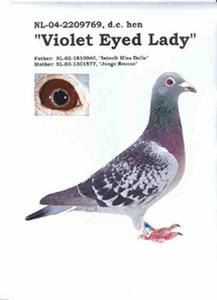
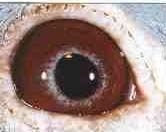
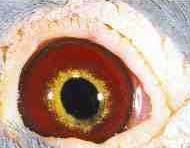

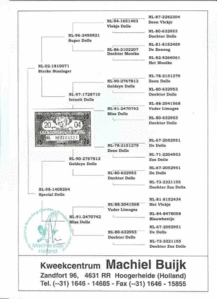

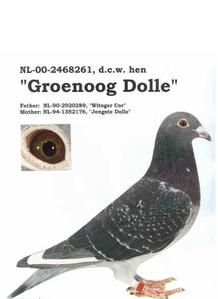



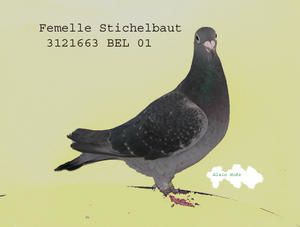

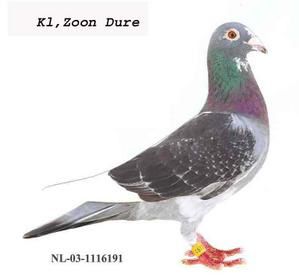
 L'oeil du Kl Zoon Dure
L'oeil du Kl Zoon Dure  Photo provisoire
Photo provisoire



 Reproduction avec l'autorisation de
Reproduction avec l'autorisation de 





























